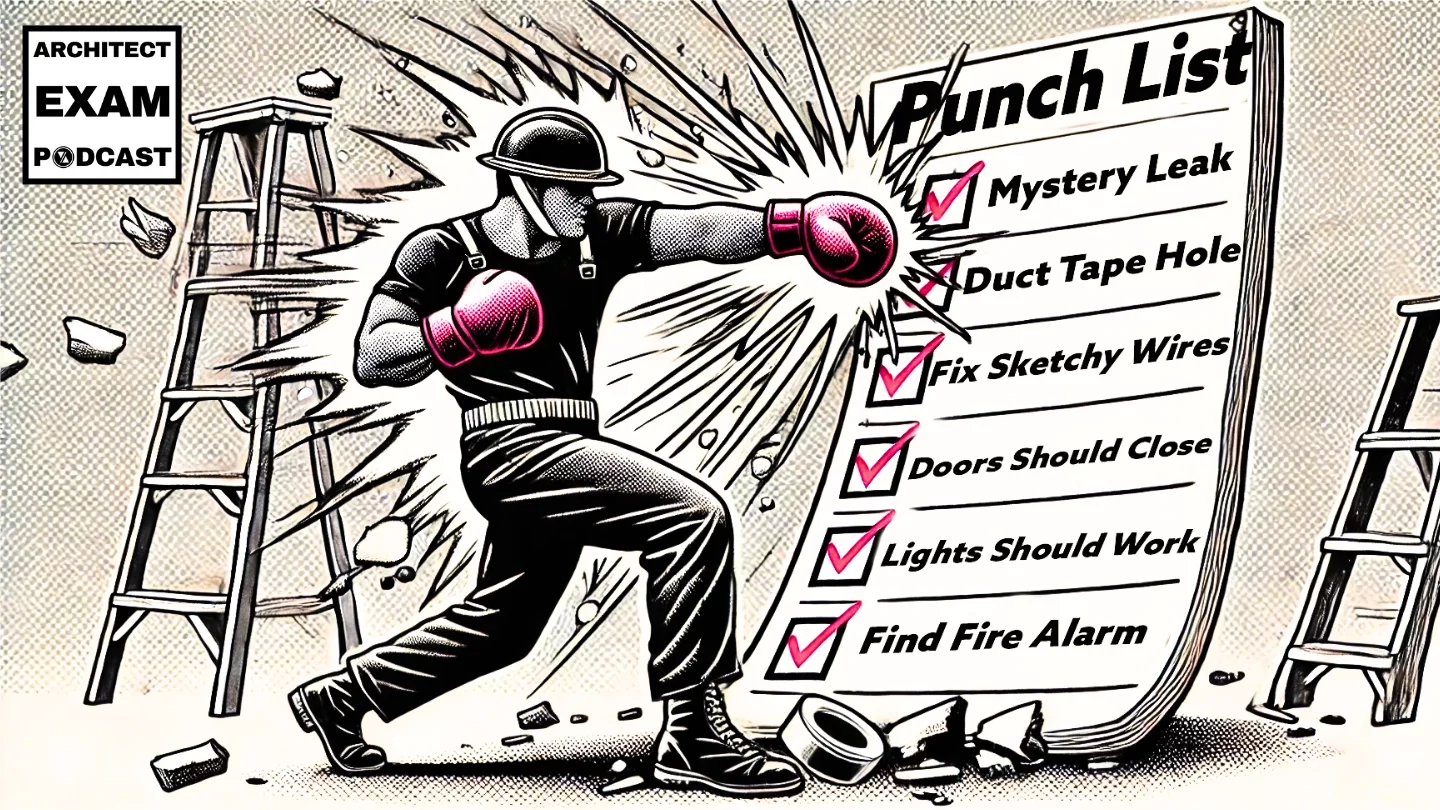Construction punch lists are the final critical step before project completion, yet there’s confusion about who creates them. While many assume architects are responsible, the contractor actually creates the initial punch list – a fact explicitly stated in industry standard documents.
This podcast is also available on YouTube, Spotify, and Apple Podcasts
The Construction Industry’s Biggest Misconception
Few topics in construction project closeout generate more debate than who creates the punch list. This confusion persists throughout the industry, with many professionals mistakenly believing it’s the architect’s responsibility. The reality, as we’ll explore, is quite different – and understanding the correct roles can prevent disputes and ensure smoother project delivery.
To fully grasp the punch list process, we must first understand another crucial concept that’s inextricably linked to it.
Understanding Substantial Completion First
Before diving into punch lists, we need to understand substantial completion, because these two concepts are inseparable.
What is substantial completion?
In simple terms, substantial completion is that moment when a building can be safely and effectively used for its intended purpose—even if minor details remain unfinished.
The official American Institute of Architects definition from AIA Document A201-2017, General Conditions of the Contract for Construction, Section 9.8.1 states:
“The stage in the progress of the Work when the Work or designated portion thereof is sufficiently complete in accordance with the Contract Documents so that the Owner can occupy or utilize the Work for its intended use.”
Understanding these contract terms isn’t just theoretical—it’s practical knowledge tested repeatedly on the ARE and CDT exams.
Think of it like this:
Imagine you’re baking a cake for a birthday party. You’ve baked it, decorated it, and it’s sitting on the table looking delicious—but you’re still missing the candles. Is the cake ready for the party? Absolutely! Those candles are essentially your punch list items—small details that can be added later without preventing use of the cake right now.
When substantial completion occurs, several important things happen:
- Responsibility shifts — the owner takes over utilities, insurance, and maintenance
- Warranties begin — this is when the clock starts ticking on warranty periods
- Payment milestones trigger — retainage starts getting released
- Legal deadlines activate — liens, statutes of limitations, and other time-sensitive matters begin counting down
The Truth About Construction Punch Lists
Now for the big reveal: The contractor is officially responsible for creating the initial punch list.
This isn’t just an opinion—it’s explicitly stated in the industry standard documents by the American Institute of Architects.
According to AIA Document A201-2017, General Conditions of the Contract for Construction, Section 9.8.2:
“When the Contractor considers that the Work, or a portion thereof which the Owner agrees to accept separately, is substantially complete, the Contractor shall prepare and submit to the Architect a comprehensive list of items to be completed or corrected prior to final payment.”
This distinction of responsibility is a frequent topic on architecture licensing exams and the CDT certification. Our courses at the Young Architect Academy emphasize the nuances of roles and responsibilities outlined in AIA contract documents, giving students confidence to navigate these relationships professionally.
This makes perfect practical sense when you think about it. Contractors are on the job site every day, managing trades and observing the work firsthand. They have the best vantage point to identify incomplete or defective items before anyone else.
Yet, this fact remains one of the most misunderstood aspects of project closeout in the construction industry. Architecture students, professionals, and even some contractors automatically assume the architect creates the punch list. It makes intuitive sense—architects are detail-oriented professionals who catch every tiny flaw, right?
The misconception is so widespread that it often leads to heated debates among construction professionals about roles and responsibilities during project closeout.
The Complete Construction Punch List Process
Let’s break down the entire punch list process step by step:
- As the project nears completion, the contractor sends notice to the architect that they believe the project is substantially complete
- Along with this notice, the contractor submits their initial punch list detailing all incomplete or defective work they’re already aware of
- The architect, owner, and contractor conduct a walkthrough together to review the project
- During this walkthrough, they review the contractor’s punch list and may add additional items that were missed
- The architect then makes a critical determination: Is the project substantially complete or not?
- If NO — The contractor continues work and the process repeats
- If YES — The architect issues a Certificate of Substantial Completion
- Once the Certificate of Substantial Completion is issued, the owner takes possession of the property (except for the punch list items still being completed)
- The contractor completes all punch list items within the agreed timeframe
- The architect/owner verifies completion of all punch list items
- Final payment, including retainage, is released
Understanding these contractual processes is essential both for passing architecture exams and for professional practice. Many candidates make the mistake of waiting too long to learn about specifications and closeout procedures!
What About Missed Items?
It’s common to worry: “What if something gets missed entirely?”
Fortunately, the AIA thought of this too. They created what’s called the one-year correction period.
According to AIA Document A201-2017, General Conditions of the Contract for Construction, Section 12.2.2.1 regarding the one-year correction period:
“In addition to the Contractor’s obligations under Section 3.5, if, within one year after the date of Substantial Completion of the Work or designated portion thereof or after the date for commencement of warranties established under Section 9.9.1, or by terms of any applicable special warranty required by the Contract Documents, any of the Work is found to be not in accordance with the requirements of the Contract Documents, the Contractor shall correct it promptly after receipt of notice from the Owner to do so, unless the Owner has previously given the Contractor a written acceptance of such condition.”
Understanding warranty periods and correction obligations is essential knowledge for both the ARE and CDT exams. We’ve created dozens of practice questions in our courses specifically addressing these contractual requirements.
This correction period is specifically designed to catch defects that reveal themselves shortly after completion, which is different from warranties that typically cover materials and workmanship over longer periods.
Best Practices for Managing Construction Punch Lists
If you want to save yourself headaches during project closeout, implement strong quality control processes and follow these best practices:
- Don’t wait until the end:
- Use “rolling punch lists” throughout construction to address issues as they occur
- Document everything clearly:
- Take detailed photos
- Write specific notes
- Specify exact locations
- Date all observations
- Prioritize items:
- Critical (affects safety or functionality)
- Important (affects aesthetics or durability)
- Minor (small details for final polish)
- Conduct pre-punch list inspections before the official walkthrough to catch major issues early
Avoiding Common Punch List Pitfalls
Even with the best intentions, construction punch lists can become problematic. Here are common pitfalls to avoid:
Communication Breakdowns
Poor communication can derail the punch list process. Ensure all stakeholders understand their roles and responsibilities. Establish clear communication channels and documentation methods from the beginning.
Warning signs of communication issues include:
- Repeated misunderstandings about completion criteria
- Conflicting expectations about quality standards
- Disagreements about what constitutes a punch list item versus a change order
Scope Creep
Be cautious about owners adding new work or design changes during the punch list process. These should be handled as change orders, not punch list items. Clear contract language that defines what constitutes a punch list item versus a change order is essential.
Timeline Management
Set realistic deadlines for completing punch list items. Consider factors like:
- Availability of specialty materials
- Access to completed areas
- Coordination with tenant move-ins
- Weather conditions for exterior work
Track progress methodically and communicate regularly about completion status to prevent delays.
Cost Implications
Extensive punch lists can have significant financial impacts. Be aware of:
- Labor costs for returning to the site
- Extended general conditions
- Potential impacts on subsequent projects
- Retainage withheld until completion
Budget appropriately for punch list completion and manage expectations about the level of perfection required for project closeout.
Take Your Construction Knowledge to the Next Level
Ready to master construction contracts, project delivery, and prepare for your exams? Our courses offer comprehensive preparation:
- CDT 101 – Deepen your understanding of construction documentation, project delivery methods, and the roles and responsibilities outlined in AIA documents
- ARE 101 – Master all divisions of the Architect Registration Exam with practice questions, case studies, and content specifically addressing contract administration topics like punch lists and substantial completion
Start Your Exam Prep Journey Today →
Why This Matters
Understanding substantial completion and construction punch lists isn’t just important for practice—it’s essential for smooth project delivery. These concepts appear throughout architecture licensing exams precisely because they’re fundamental to protecting the health, safety, and welfare of the public.
When projects close out correctly, everyone benefits—owners get what they paid for, contractors receive final payment, and architects fulfill their professional obligations.
Final Thoughts
Understanding who creates the punch list might seem like a small detail, but it represents a much larger principle in architecture and construction: clarity about roles and responsibilities prevents disputes and ensures successful projects.
Remember:
- The contractor creates the initial punch list
- The architect verifies and may add to the list
- The owner ultimately accepts the completed work
By understanding this process correctly, you’ll not only be better prepared for your exams but also become a more effective design professional in the field.



